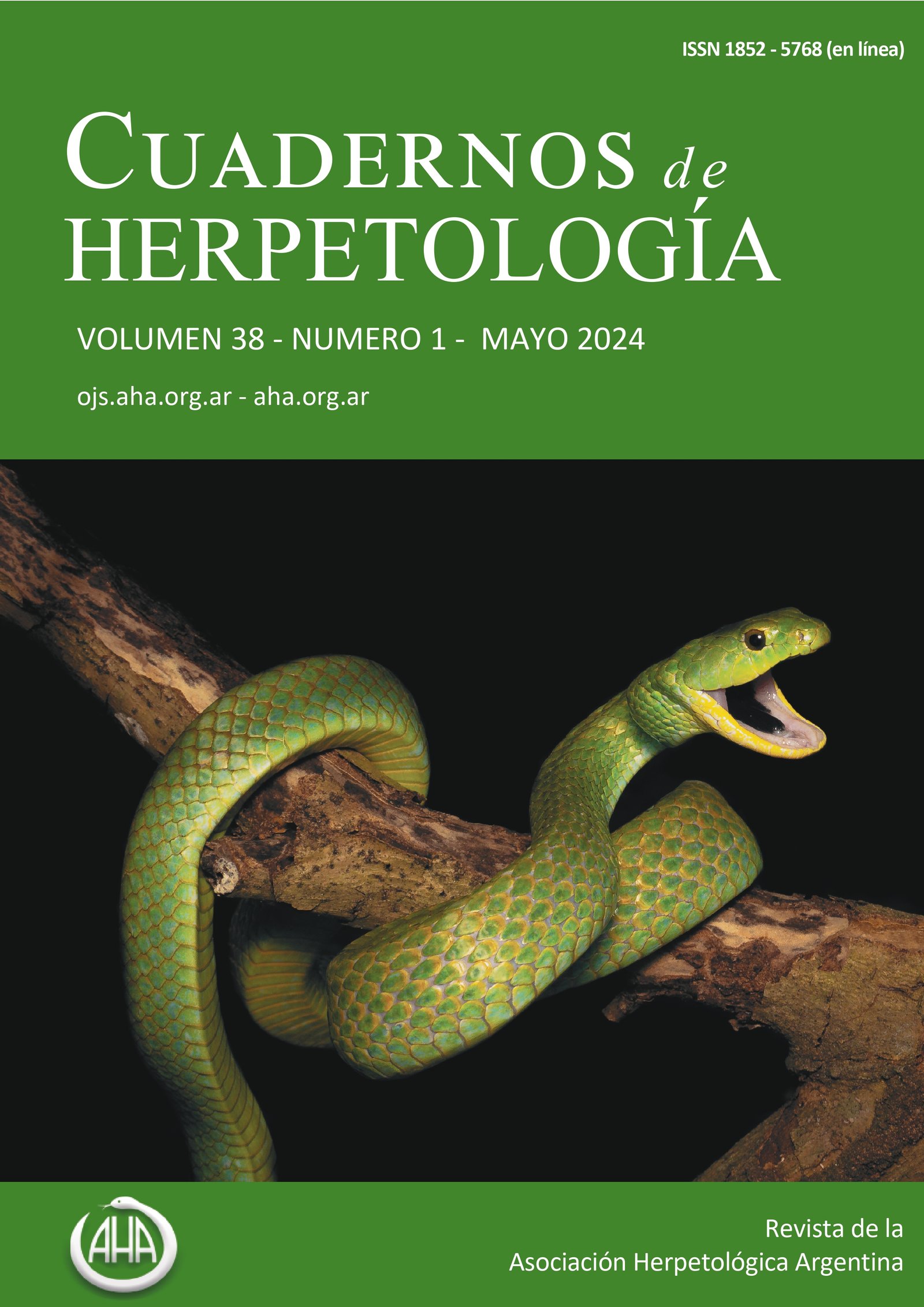Predation events involving herpetofauna in the Caatinga region, Brazil
Keywords:
Snakes, Amphibians, Predators invertebrates, Caatinga biomeAbstract
We document for the first time three predation events notoriously hard to come by in the Caatinga biome in Brazil: Philodryas nattereri by preying on a specimen of Leptodactylus sp.; the predation of Tropidurus hispidus by the spider Iridopelma katiae; and the predation of Gymnodactylus geckoides by T. hispidus. Although these are basic records, the descriptions of the predation vents contribute to the knowledge of the diet of different species of herpetofauna in a Brazilian biome that is threatened by accelerated deforestation.
References
Benício, R.A., Carvalho, T., Barbosa, M.D.R., Costa, J.M., Silva, F.C.C. & Fonseca, M.G. 2019. Worrying news for Brazilian Caatinga: Prevalence of Batrachochytrium dendrobatidis in Amphibians. Tropical Conservation Science 12: 1-6.
Camardelli, M. & Napoli, M.F. 2012. Amphibian conservation in the Caatinga biome and semiarid region of Brazil. Herpetologica 68: 31-47.
Coelho-Lima, A.D., Oliveira-Filho, J.M. & Passos, D.C. 2019. Philodryas nattereri (Paraguay Green Racer). Diet. Herpetological Review 50: 601.
Dias, D.M., Guedes, P.G., Silva, S.S.P. & Sena, L.M.M. 2017. Diversity of nonvolant mammals in a Caatinga area in northeastern Brazil. Neotropical Biology and Conservation 12: 200-208.
Duellman, W.E. & Trueb, L. 1986. Biology of amphibians. McGraw Hill, New York.
França, F.G.R., Mesquita, D.O., Nogueira, C.C. & Araújo, A.F.B. 2008. Phylogeny and ecology determine morphological structure in a snake assemblage in the central Brazilian Cerrado. Copeia 2008: 23-28.
Guedes, T.B., Nogueira, C. & Marques, O.A.V. 2014a. Diversity, natural history, and geographic distribution of snakes in the Caatinga, Northeastern Brazil. Zootaxa 3863: 1-93.
Guedes, T.B., Sawaya, R.J. & Nogueira, C.C. 2014b. Biogeography, vicariance and conservation of snakes of the neglected and endangered Caatinga region, north-eastern Brazil. Journal of Biogeography 41: 919-931.
Mesquita, P.C.M.D., Borges-Nojosa, D. M., Passos, D.C. & Bezerra, C.H. 2011. Ecology of Philodryas nattereri in the Brazilian semi-arid region. Herpetological Journal 21: 193-198.
Mesquita, P.C.M.D., Passos, D.C., Borges-Nojosa, D.M. & Cechin, S.Z. 2013. Ecologia e história natural das serpentes de uma área de Caatinga no nordeste brasileiro. Papéis Avulsos de Zoologia 53: 99-113.
Pombal Jr., J.P. 2007. Notas sobre predação em uma taxocenose de anfíbios anuros no sudeste do Brasil. Revista Brasileira de Zoologia 24: 841-843.
Ribeiro, L.B. & Freire, E.M.X. 2011. Trophic ecology and foraging behavior of Tropidurus hispidus and Tropidurus semitaeniatus (Squamata, Tropiduridae) in a caatinga area of northeastern Brazil. Iheringia, Série Zoologia 101: 225-232.
Sales, R.F.D., Sousa, J.D., Lisboa, C.M.C.A., Marinho, P.H., Freire, E.M.X. & Kokubum, M.N.C. 2020. New dietary records and geographic variation in the diet composition of the snake Philodryas nattereri in Brazil. Cuadernos de Herpetología 34: 1-9.
Toledo, L.F. 2005. Predation of juvenile and adult anurans by invertebrates: currente knowledge and perspective. Herpetological Review 36: 395-400.
Vitt, L.J. & Vangilder, L.D. 1983. Ecology of a snake community in Northeastern Brazil. Amphibia-Reptilia 4: 273-296.
Downloads
Published
How to Cite
Issue
Section
License
Copyright (c) 2024 Darlison Chagas-de-Souza, Ivan Alves dos Santos-Jr., Gustavo Henrique dos Anjos Rodrigues, Lucas José Clemente Figueira, Bruna Thaís da Cruz Santos, Rafael Ávila Grisostenes, Tássio Alves Coêlho

This work is licensed under a Creative Commons Attribution-NonCommercial-NoDerivatives 4.0 International License.
Attribution-NonCommercial-NoDerivatives 4.0 International
You are free to:
Share — copy and redistribute the material in any medium or format
Adapt — remix, transform, and build upon the material
The licensor cannot revoke these freedoms as long as you follow the license terms.
Under the following terms:
-
Attribution — You must give appropriate credit, provide a link to the license, and indicate if changes were made. You may do so in any reasonable manner, but not in any way that suggests the licensor endorses you or your use.
-
NonCommercial — You may not use the material for commercial purposes.
- No additional restrictions — You may not apply legal terms or technological measures that legally restrict others from doing anything the license permits.





